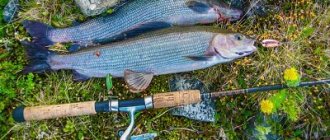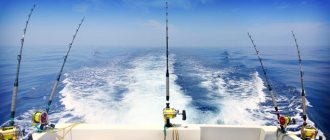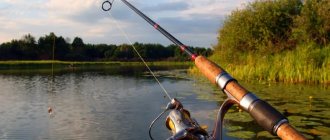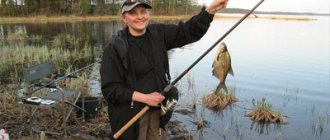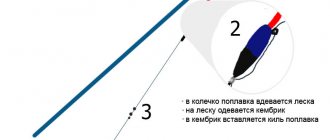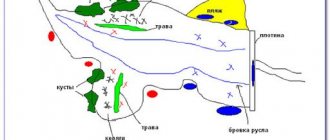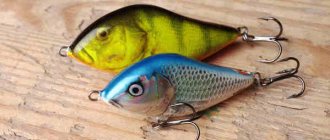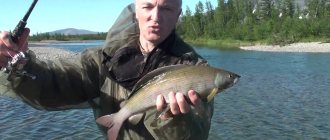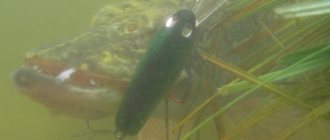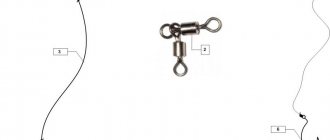Many anglers will agree that fishing tackle for roach in the summer is the most effective float tackle for this time of year. This method has proven itself well when fishing on the river, when the current draws the bait into the waters of tree branches hanging over the reservoir and along the border of coastal aquatic vegetation. Indeed, during the current, the roach behaves more boldly and decisively. Catching roach in line is a fairly active type of fishing. Catching fish this way will give you a lot of pleasant emotions and, of course, a good catch.
Assembling fishing tackle into wiring
For this method of fishing, a telescopic rod with blind rigging and a length of about five to six meters is used. It is equipped with a reel and guide rings. Approximately 30-40 meters of fishing line with a diameter of 0.18 - 0.2 mm are wound onto the reel. A sensitive float, special for fishing in currents, equipped with a long keel, sinkers, and a leash with a hook are attached to the fishing line. For the leash, take a fishing line 20-35 cm long and 0.15 mm in diameter, hooks are selected depending on the nozzle, the universal option is No. 10. If the catch of roach will take place in places where the depth of the reservoir exceeds the length of the rod, it is necessary to use a sliding float together with a stopper on the fishing line. Such a float allows you to throw tackle to remote places and even to the opposite bank of the river.
Dependence of wiring on the type of coils
Casting using inertia-free models does not allow the bait to move freely with the current and without jerking. The fish do not like this behavior of the food. To fix the problem, you need to work with the rod - point its blank in the direction of the current, and wait until the stick follows the float in a smooth arc, release about 2 meters of line from the reel, and return the rod to its original position. True, even this does not always help to avoid torn wiring.
To learn more:
The best colors of spinners for pike fishing
The use of inertial-type reels (often called “flying”) allows for more effective bait presentations without the use of a fishing rod. By holding the drum with your finger, it is much easier to adjust the delivery speed of the nozzle. The line will move without jerking, and the bait will not jump.
Such reels have proven themselves to work over long distances, allowing you to slow down the equipment by lightly holding the drum. And in places with strong currents, the brake can be set in such a way that the reel line will unwind on its own. The fisherman will only have to pause it at the right moment in order to carry out the hold.
Wire fishing technique
Catching roach in a fishing line on the river is carried out as follows: the float is carried out by swimming, the nozzle should be lowered 3-10 centimeters from the bottom. You need to hold the bait every few meters of swimming. The stop only lasts a couple of seconds, especially if the current is strong. Here you need to adhere to the principle: the faster the flow speed, the shorter the hold. A fast flow of water can lift the bait 60 cm from the bottom in one to two seconds. From such a height it will sink to the bottom, playing and attracting the attention of fish.
Fishing tactics
How does fishing by wire differ from other fishing techniques? A novice angler who is used to fishing on lakes and has mastered this skill can expect the fish to lead or dip his float. But you shouldn't wait for this.
If you are fishing with a retrieve, do not forget to take into account that when using this technique, the fish does not swallow the bait, but only pulls the bait into its mouth for a while. When the fish feels resistance or the prick of the hook, it immediately throws out the bait. The sharpness of the hook and the precise weight of the float are very important here, which allows you to notice even the slightest touch of the fish to the bait. The oscillations of the float give the fisherman the opportunity to respond to them with an immediate hook. If casting the tackle is unsuccessful, it should be repeated, but do not forget to check each time whether the nozzle is damaged.
The second thing a beginner should master is the ability to skillfully handle the tackle after the fish has bitten, especially if you have caught large prey. Never grab the line with your hand immediately after catching. The fish needs to be held on the rod for a while and only then brought to the boat to catch the prey.
Fishing in the rivers during the current
It is very convenient to fish while fishing on small rivers. This fishing method is especially good in small rivers that flow into lakes or reservoirs during the spawning of non-predatory fish. This period is very short, only about a week, but if you manage to catch it, you can get a lot of pleasure from fishing.
But even if you missed the spawning period, don’t be upset! You can fish if you know the main promising places: near riffles, areas with reverse flows and the boundaries of the channel flow.
Choose a fishing rod with a short rod. It is easier to handle on steep and overgrown banks. A good choice would be a regular match fishing rod with rings, equipped with an inertial reel and a stick-type float. The length of such a fishing rod should be 4 meters. The optimal diameter of the fishing line for the rod will be 0.12 mm.
Wire fishing on lakes
More often they fish by wire only in places where there is a current, but this method can also be used on lakes. It just requires good gear and wind. It may well compensate for the lack of current in the lake.
All components of your fishing rod should be strong, light and adjusted. The design of the fishing rod determines the distance to which the bait is cast and the speed of fishing for the caught fish. A good fishing rod is the key to your success.
It is very important to choose a sensitive float. Its sensitivity depends on the shape, size, color and method of attachment. To catch fish while fishing, it is better to use a sliding float, the base of which is made of a ballpoint pen. A lead weight is attached to the bottom of such a float.
If you take these details into account, fishing on the lake will be no worse than river fishing.
Fishing on reservoirs with wiring
In reservoirs with weak currents or no current at all, fishing is done from a boat or from the shore. The length of the line on your fishing rod should be one and a half meters longer than the rod. If you are fishing from a boat, you can simply place the rod on board for convenience.
In spring and summer, the optimal depth for fishing in reservoirs is 3 meters. With colder weather and the arrival of autumn, the fish looks for warmer places, moving closer to the bottom.
Read more:
Fishing for grass carp - gear and tactics
The depth of fishing greatly depends on where the fish are located. When fishing, for example, bream, the bait is placed at the very bottom. Do not forget that when catching any fish you need to be quiet, otherwise it may get scared and leave its place. If you want to cast a fishing rod in places that are heavily overgrown with vegetation, you need to bring the boat to the thickets and then sail along them. As soon as a clearing appears, immediately throw the bait into it.
Note to the fisherman! An angler's best friend is silence. For fishing, it is best to choose places away from the highway, factories, beaches and places beloved by tourists. Try not to make noise yourself, do not whistle or shout. Don't play loud music.
Compliance with this simple condition will definitely lead you to success, and you will be able to show off your good catch to your friends!
Groundbait and bait for roach in the wiring
Before you start fishing, you must feed the fish. Bait can be purchased at a fishing store, or you can simply use flour or white bread, adding bloodworms, maggots or finely chopped worms. You can use a fine mesh with a sinker as a feeder. The weight of the sinker should be sufficient to prevent the feeder from being carried away by the current. Having laid the bait mixture, we lower the feeder to the bottom, where the food will gradually wash out, attracting fish to the fishing spot.
As bait, you can use any food that roaches prefer to catch in the summer. These can be pieces of dough or bread crumb, as well as other attachments, preferably of plant origin: corn, peas or even algae. Despite the summer vegetarianism of roach, worms and maggots also give good bite results.
If you have assembled your gear correctly, chosen a fishing spot and stocked up on bait, fishing for roach in the wire will give you real pleasure. And we wish you good luck!
What kind of fish are caught in wiring?
With the help of wire fishing you can catch a wide variety of fish. To catch ide, use a float tackle. The bait is cast upstream, then it is carried along the river by lowering the fishing line. The bait can become more visible to the school if you play with the float, holding it and then releasing it. You can catch ide using fishing from the shore, standing on a scaffold, or from a boat.
In the spring, chub are caught in the wire. Rivers flood and drive fish out of their winter shelters, and they begin to look for food.
In summer, you can try your hand at perch fishing. It's a lot of fun, even though it's not easy to catch a perch. Fishing from a boat will be more effective. You can use a vertical spoon as a tackle. The boat should be allowed to float freely, and the bait should move at shallow depths. You also need to jerk the rod sharply.
To catch bream, you need to choose calm rivers with a depth of no more than 3 meters. Fish of the carp family are often found in such rivers. Experienced bream hunters are advised to examine fishing spots in advance, since bream is a very shy fish. The best period for catching bream is from late May to November in the morning.
Read more:
How to store bloodworms at home
Tackle
For float fishing for roach in the spring, use Bolognese or fly tackle.
The Bolognese fishing rod is equipped with guides and a reel. It is intended for long-distance fishing. The reel does not play a decisive role when fishing for roach, so you can even use an inertial reel model.
If the roach is close to the shore, a fly rod is used. This rod has no guides and is blind rigged. But fly tackle is easier to control and more mobile.
For roach, delicate fishing line is used. The cross-section of the main line should be 0.16mm. The leashes should be a little thinner. If you fish with Bolognese tackle at a greater distance, use a fishing line with a cross-section of 02 mm. Floats for spring roach fishing can also be different.
For a Bolognese fishing rod, a sliding type of float is selected. Blind mounting is suitable for fly tackle. When fishing with wiring, the float should be elongated. In any case, he should be able to hold himself upright and be sensitive.
Roaches have a small mouth, so small hooks are chosen. Hooks are selected according to the size of the bait. For maggots, only one hook is chosen, but for worms, hooks with a long shank are needed. In the spring, a leash 25-35 cm long is made for cautious roach. The equipment should move freely in the current and not frighten the fish.
What is wiring?
The use of float gear (the so-called “Bolognese”) is a prerequisite for fishing from a boat or from the shore to please fans of such fishing with excellent results. The depth of the river should be sufficient for the bait on the hook to pass along the bottom, practically touching it.
The process is not complicated: after releasing the equipment into the water (while avoiding the fishing line getting caught on one of the rings), the reel is released and, placing the float on the current, it is sent into free swimming. The bait on the hook must be moved above the feeding areas.
There are three types of postings:
- the usual simplest technique (passive, with holding and catching with a wire);
- long-distance bait delivery technique;
- short-range wiring technique.
The simplest technique
In this way, the line is easily released from the reel, allowing it to move evenly with the current. This makes it easier for the nozzle to change its position and adapt to the movement of water. A technique that does not require much effort from the fisherman is called passive or free. It justifies itself in places where schools of bottom dwellers gather and when there is active biting.
However, anglers more often use the holding technique, slowing down the unwinding of the fishing line from the reel spool with their finger. In this case, the float stops, moving at a lower speed than the water, and the nozzle rises upward under the influence of the current. After some time, the line is released again, and the tackle moves on.
Such movements of the food attract the attention of fish and provoke them to swallow the bait.
In cases where the float, while being held, jumps out of the water column or rapidly approaches the coastal zone, the number of manipulations should be reduced.
From time to time the angler must hold the tackle. The wiring will be effective if the depth is set correctly and the antenna on the float tilts with the current. The application of the technique proves its effectiveness in the case when a school of fish is in the middle layers.
Far technique
The wisdom of this option is that the gear allows you to swim a distance of 20-30 meters. It should be noted that the initial casting distance should not exceed the length of the rod by more than twice. Long-distance fishing is preferred in water areas with strong currents and depths of no more than three meters, as well as in cases where a diligent fisherman has to fish hard-to-reach places, and casting is done in a strong tailwind.
In practice, this wiring is carried out according to the following scheme: the float is thrown to the required distance from the shore line, for some time it moves downstream to the original point of wiring. Then, by controlling the holding force of the floating float, it is forced to move along the desired trajectory.
In cases where the wind blows the float towards the fisherman, the tackle must be cast further away, and when he approaches the starting point of the retrieve, move it to the required distance with the help of a rod, controlling the strength and holding time.
Close wiring
This fishing technique is most common and is used in places with great depths and slow water movement. It depends on the influence of the wind (a vortex with the current interferes, but against it helps), and strong gusts do not allow the use of short-range guiding methods at all.
This type of bait delivery is carried out at distances ranging from 10 to 15 meters. It allows you to fish over long distances (maximum performance depends on the length of the rod used and the depths in the fishing areas). Such postings require close attention to ensure that the telescope or feeder stick is located towards the shore, and the angle between the float and the fishing line hanging from the tip of the rod relative to the angler’s location is close to 90°.
You need to get used to the process, since at first it will be difficult to keep the float on the desired trajectory. The success of fishing depends not only on the speed of the current, the number and frequency of holds, but also on the weight of the equipment. Weakly loaded tackle is harder to stop in time, but if you make it heavier, you will lose the sensitivity of bites.
